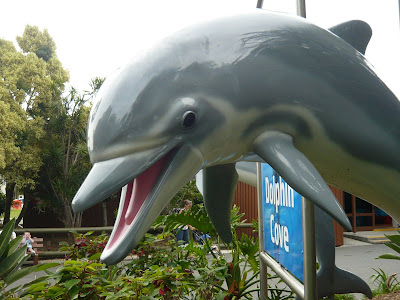
Sunday, November 18, 2007
What is Dolphin?
Dolphins are aquatic mammals that are closely related to whales and porpoises. There are almost forty species of dolphin in seventeen genera. They vary in size from 1.2 metres (4 ft) and 40 kilograms (88 lb) (Maui's Dolphin), up to 9.5 m (30 ft) and ten tonnes (the Orca or Killer Whale). They are found worldwide, mostly in the shallower seas of the continental shelves, and are carnivores, mostly eating fish and squid. The family Delphinidae is the largest in the Cetacea, and relatively recent: dolphins evolved about ten million years ago, during the Miocene.

Dolphins are considered to be amongst the most intelligent of animals and their often friendly appearance and seemingly playful attitude have made them popular in human culture.


Imagine, an enchanting new interactive Dolphin Show has opened at Sea World’s Dolphin Cove. Delight at this unique and wondrous presentation starring the world’s most popular and endearing marine mammals. Set to a beautiful musical score and featuring a series of exciting interactions, Imagine is both educational and entertaining.
Human activities can harm dolphins.
In some parts of the world, humans hunt certain types of dolphins for food. Yet even where they're not hunted, dolphins are threatened by some human activities.
Toxic chemicals that pollute nearshore waters may contaminate the fish on which dolphins feed. Scientists believe these chemicals might affect the health of dolphins and cause tumors. Pollution may have contributed to the deaths of dolphins that have washed up on beaches in recent years.
In the eastern tropical Pacific ocean, tuna travel under dolphin pods. When tuna fishermen set their nets around the dolphins to catch the tuna, the dolphins are trapped too. To help save dolphins, many tuna fishermen now use special nets and techniques to release the dolphins. From 1972 to 1994, dolphin deaths from purse seine fishing in the eastern tropical Pacific dropped more than 99%, from 423,678 to 4,095 individuals.
A more deadly type of fishing is done with gill nets. These nets stretch for miles across the ocean and extend deep under water. Once the fishermen have set the nets, they leave and return a few days later to haul them in. They remove the fish they were hoping to catch and discard all other animals that have died in the nets. Thousands of dolphins and other marine creatures drown in these huge nets each year.
Toxic chemicals that pollute nearshore waters may contaminate the fish on which dolphins feed. Scientists believe these chemicals might affect the health of dolphins and cause tumors. Pollution may have contributed to the deaths of dolphins that have washed up on beaches in recent years.
In the eastern tropical Pacific ocean, tuna travel under dolphin pods. When tuna fishermen set their nets around the dolphins to catch the tuna, the dolphins are trapped too. To help save dolphins, many tuna fishermen now use special nets and techniques to release the dolphins. From 1972 to 1994, dolphin deaths from purse seine fishing in the eastern tropical Pacific dropped more than 99%, from 423,678 to 4,095 individuals.
A more deadly type of fishing is done with gill nets. These nets stretch for miles across the ocean and extend deep under water. Once the fishermen have set the nets, they leave and return a few days later to haul them in. They remove the fish they were hoping to catch and discard all other animals that have died in the nets. Thousands of dolphins and other marine creatures drown in these huge nets each year.
What You Can Do for Dolphins!!!!!

Reduce, reuse, and recycle your trash so it doesn't end up in the ocean.
Encourage friends and family to properly dispose of toxic wastes like paint and car oil at special collection sites, rather than pouring them down the drain.
Write letters to your congressional representative supporting legislation that helps keep our oceans clean and protects dolphins.
Support aquariums, zoos and museums that conduct accredited dolphin conservation programs.
Saturday, November 17, 2007
feeding
They feed on a large variety of prey such as small mammals, birds and even domestic livestock. Crocodiles grab their prey and move to deep water, where they roll over to drown the animal. They can leap high out of the water to reach their prey if necessary.
Australian Crocodiles
There are two kinds of crocodiles in Australia: the Estuarine, a saltwater crocodile and Johnsons, a freshwater crocodile. Both are found in the hot, tropical northern part of the continent.
Subscribe to:
Comments (Atom)































